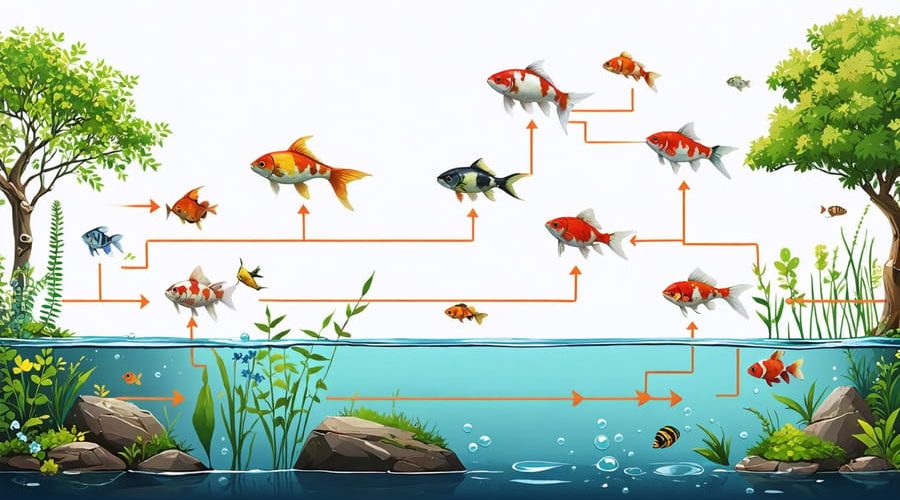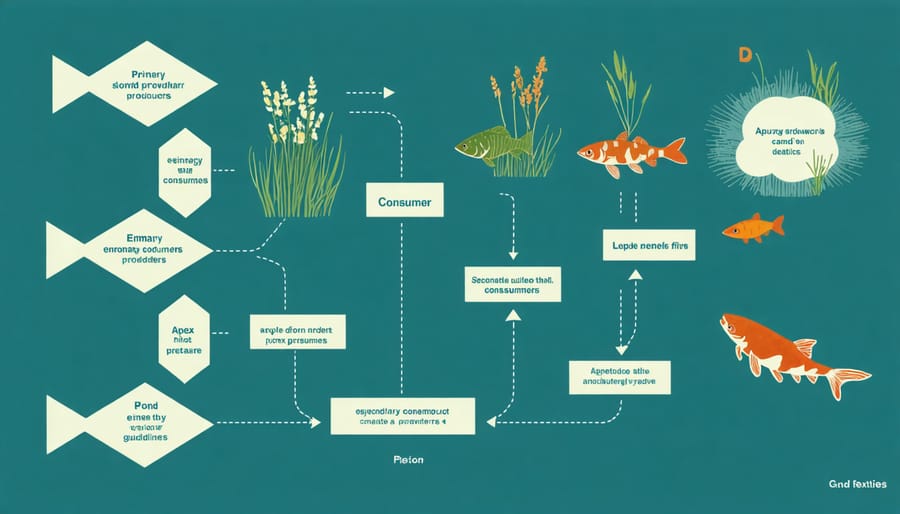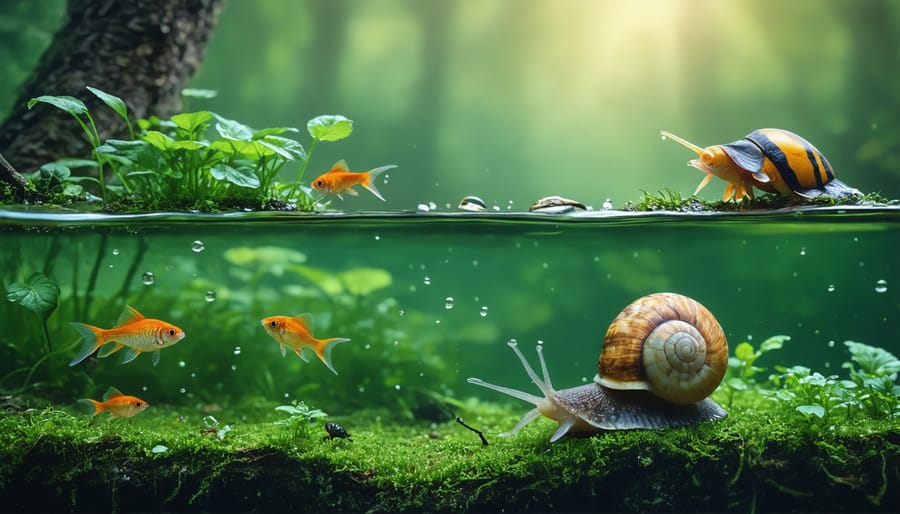
Keeping the Balance: How the Food Chain Sustains Your Backyard Pond
Discover the fascinating world of pond ecosystems, where a delicate balance of life unfolds beneath the tranquil surface. From microscopic algae to majestic fish, each organism plays a vital role in a complex food web that sustains and enriches the aquatic environment. Explore the intricate relationships between producers, consumers, and decomposers as energy flows and nutrients cycle through the pond’s living tapestry. Uncover the importance of top predators in maintaining equilibrium and learn how you, as a pond owner, can support this natural balance through thoughtful management practices. Dive into the captivating realm of pond ecology and gain a deeper appreciation for the unseen wonders thriving in your own backyard oasis.

The Pond Food Chain Explained
Producers
In a pond ecosystem, producers form the foundation of the food chain by harnessing the sun’s energy to create organic compounds through photosynthesis. Aquatic plants like water lilies, cattails, and duckweed, as well as microscopic algae, are the primary producers in this underwater world. These green powerhouses utilize sunlight, carbon dioxide, and nutrients to synthesize glucose, which serves as the essential fuel for their growth and reproduction. In turn, this plant matter becomes a vital food source for primary consumers, such as zooplankton, snails, and herbivorous fish. Without producers efficiently converting solar energy into consumable biomass, the intricate web of life in the pond would quickly unravel. By supporting a robust community of aquatic plants and algae through proper nutrient management and sunlight exposure, pond enthusiasts can ensure a thriving and balanced ecosystem that sustains a diverse array of aquatic creatures.
Primary Consumers
Zooplankton, like water fleas and rotifers, are tiny herbivores that graze on algae and phytoplankton, forming the foundation of the pond food web. Their rapid reproduction provides a constant food supply for larger creatures. Tadpoles, the aquatic larvae of frogs and toads, also feed on algae and plant matter during their early development. Snails, such as ramshorn and pond snails, scrape algae off surfaces with their rasping tongues. Other primary consumers include herbivorous fish like mollies and plant-eating insects like water boatmen. These diverse herbivores play a vital role in converting plant energy into animal biomass, fueling the next tiers of the food chain. By keeping algae growth in check, they help maintain water clarity and oxygen levels. Supporting a healthy population of primary consumers through proper pond management is key to a thriving ecosystem.
Secondary Consumers
Insect larvae, small fish, and amphibians make up the secondary consumers in a pond ecosystem, feeding on the herbivores that graze on algae and aquatic plants. Dragonfly and damselfly nymphs, water boatmen, and diving beetles prey on zooplankton and small invertebrates. Minnows, juvenile fish, and tadpoles also consume these tiny herbivores, helping to keep their populations in check. As these secondary consumers grow, they become food for larger predators higher up the food chain. By maintaining a balanced population of herbivores, the secondary consumers play a crucial role in the overall health and stability of the pond ecosystem.
The Vital Role of Apex Predators
Apex predators like koi and bass play a crucial role in maintaining the delicate balance of your pond ecosystem. These larger fish sit at the top of the food chain, helping to control the populations of smaller fish, tadpoles, and invertebrates. Without these predators, the lower levels of the food web can quickly become overrun, leading to algae blooms, oxygen depletion, and other issues that threaten the health of your pond.
Koi and bass are not only beautiful additions to your water garden but also natural regulators of the ecosystem. They prey on excess fry (baby fish) and tadpoles, preventing any one species from dominating the pond. This helps maintain water quality and ensures that there are enough resources for all inhabitants to thrive.
When stocking your pond, it’s essential to strike the right balance between predators and prey. A good rule of thumb is to have one koi or bass for every 10 to 20 smaller fish. This ratio allows the apex predators to control overpopulation without decimating the lower levels of the food chain.
By incorporating these majestic fish into your pond and maintaining a balanced ecosystem, you’ll create a harmonious and visually stunning environment that will bring you joy for years to come.
Supporting a Balanced Pond Food Web
Thoughtful Fish Stocking
When stocking your pond, it’s crucial to choose a balanced mix of species that will establish a natural hierarchy and support a thriving ecosystem. Start by introducing a variety of forage fish, such as fathead minnows or mosquitofish, which will serve as a food source for larger predators. Next, add some mid-level predators like golden shiners or rosy red minnows to keep the forage fish population in check. Finally, top off your pond with a few impressive specimen fish, such as koi or golden orfe, which will act as the apex predators in your miniature underwater world.
Remember, the key to a healthy pond is striking the right balance between prey and predator species. Avoid overstocking, as this can lead to water quality issues and stress on your fish. As a general rule, aim for one inch of fish per square foot of pond surface area. With thoughtful planning and a diverse mix of species, you’ll create a captivating aquatic ecosystem that will delight both you and your guests. For more inspiration, check out these charming small pond ideas to transform your outdoor space.
Encouraging Aquatic Vegetation
Encouraging the growth of aquatic vegetation is crucial for maintaining a healthy pond ecosystem. Submerged plants like hornwort and anacharis provide oxygen through photosynthesis, while floating plants such as water lilies and duckweed offer shade and shelter for aquatic life. Marginal plants around the edges, including rushes and cattails, filter nutrients and stabilize the shoreline.
To promote aquatic vegetation, start by choosing native species well-suited to your climate and pond conditions. Plant a diverse mix of submerged, floating, and marginal plants to create a balanced ecosystem. Avoid introducing invasive species that can quickly overtake your pond.
Ensure your plants receive adequate sunlight and nutrients, but be cautious not to overfertilize, as excess nutrients can lead to algae blooms. Regular natural pond aeration can help circulate water and prevent stagnation, promoting healthier plant growth. With proper care and maintenance, your aquatic plants will thrive, providing a vital foundation for the pond’s food chain.

Avoiding Overfeeding
Allowing the pond food chain to regulate fish populations naturally is the best way to maintain a healthy ecosystem. Overfeeding your fish can disrupt this delicate balance by introducing excess nutrients that fuel algae growth and degrade water quality. Instead, let the pond’s inhabitants find their own food sources, such as algae, insects, and aquatic plants. Supplement their diet sparingly, and only when necessary. Keep an eye on your fish’s condition and behavior – if they appear healthy and active, they’re likely finding enough to eat on their own. Remember, a well-balanced pond with thriving plants and a diverse community of organisms will sustain itself through natural food webs. If you do need to feed your fish, choose high-quality, species-appropriate foods and follow the manufacturer’s guidelines to avoid overfeeding. By letting nature take its course and monitoring pond water chemistry, you’ll create a self-sustaining ecosystem that supports a vibrant array of aquatic life.
Conclusion
In conclusion, understanding the intricate food chain within your backyard pond ecosystem is key to cultivating a thriving, balanced aquatic environment. By recognizing the vital roles played by producers, consumers, and decomposers – from algae and aquatic plants to invertebrates, fish, and beneficial bacteria – you can make informed decisions to support the natural harmony of your water garden. Through thoughtful pond management practices like proper fish stocking, planting a diverse array of vegetation, and providing supplemental food when necessary, you have the power to create a beautiful, self-sustaining oasis that will bring you joy for years to come. Embrace the wonders of your pond’s food web and watch as nature unfolds its magic right before your eyes.
